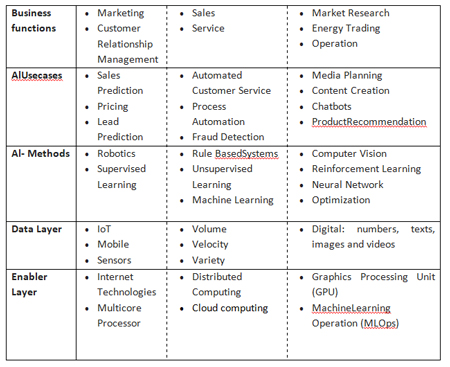THANK YOU FOR SUBSCRIBING

Enterprise AI Adoption Based on Experience
Kreecha Puphaiboon, Head Of AI/ML, Banpu Public Company Limited, BANPU Public Company Limited


Kreecha Puphaiboon, Head Of AI/ML, Banpu Public Company Limited
The article is written from a technical hands-on experience in Artificial Intelligence (AI) in scientific, banking and energy industries. I want to share how to implement AI in companies, from on my own experience.
Personally, the most important step is to set the definition of Artificial Intelligence (AI) in your organization. Peter Norvig from Google defines AI as the designing and building of intelligent agents that perceives from the environment and take actions that affect that environment. AI is not just applying advanced analysis and logic- based techniques, like Excel, machine learning (ML), to support decision making. But AI also needs to automatically perform intelligent actions for humans. The definition of AI must be clearly agreed from all levels within the organization e.g., boards, management and operation. Otherwise, we will see confusion. For examples, I was asked to use Excel to perform loans and asset valuation with thousands of customers in real-time and users still want to edit and verify. Then, people showed me that they can do AI with Excel decision tables, solver, or linear regression. To me this is data analytics where people still want to analyze data, make judgements or conclusions about the information.
Generally, AI is expected to improve businesses. Thus, business benefits or AI objectives must be clearly quantified so that AI results can be measured. Consequently, all stakeholders can have the same business target. My past AI project goals were: reducing operational costs –how much in dollar (explicitly 1 million USD/year), improving customer experience (click-through-rate increased by 3 percent after 2 months) and increasing revenue by 10 percent of loans and deposits. These clear numerical objectives helped in implementing AI projects and tracking outcomes on annual basis.
There are business opportunities where AI can improve Banpu abilities to: increase productivity and operational efficiencies; save time and money by automating and optimizing our coal mining routine tasks; make faster business decisions by adopting AI techniques; minimize human errors on day-to-day operations; use vast amount of data so that we can identify cause and effect (causality) of interested outcomes.
For AI Adoption in the organization, we must have Enterprise AI Strategy: centralize, decentralize or hybrid where data and models are managed by whom; educate management about data, data strategy/governance, data is vital as AI needs data to process.
If data is wrong, then AI will act badly. Data governance is crucial so when having issues with data we need someone to escalate, permit, fix and deploy; infrastructure whether on-premises, cloud or hybrid because you will need to enable skills of engineers.
Table 1: Enterprise AI Adoption Framework
A couple of points to note: have a clearly defined and measurable objective that creates business value e.g., financial benefits; If you have multiple ideas for the business – go for low hanging fruits first and measure business values, additionally start with something that users really needed or they believe AI can help.
‘AI Do or Buy’, Do: If you have skillful resources; your business ideas are innovative and future proprietary; general products can not satisfy business needs, this can range from AI mathematical models are niches/complex and need to use thousands of computers to compute. Buy: when you find the products available right away in the market;compare financial benefits and give you profit margins; you don’t have time to develop, based on my experience AI development takes 6 months minimum, 1 year average. As, AI is an iterative process - build trust with users, show satisfactory outcomes, and take buy-in to continue within the organization - this takes time.
AI is not just applying advanced analysis and logic- based techniques, like Excel, machine learning (ML), to support decision making. But AI also needs to automatically perform intelligent actions for humans
AI action plan start with how many people andskills; business models; processes, stakeholders; establish team to define success metrics; identify approach (AI to augment only or automate execution); timeline to complete an AI project; computing power and cloud adoption; computing scalability; tools & processes and procedures using ML/Ops to streamline operations.
Risks and drawbacks in adopting AI: expectations where there is an expectation AI can be implemented quickly. Sometime we may not be lucky to get the right model and accuracy. We need to make our expectations clear; data is not sufficient or quality of data is not met; executive and users are not supporting AI projects, as some users may resist or afraid of losing control/job; AI Security, fairness and ethics, these to be discussed at the early stages; corporate culture, such as meetings, presentations, trainings and administrative works which deprive AI engineers’ time to model, perform mathematical analysis, and code hundreds of computers in order to achieve business benefits. I hope with the trend of AI, we can expect organizations to adopt AI successfully and improve business benefits.












